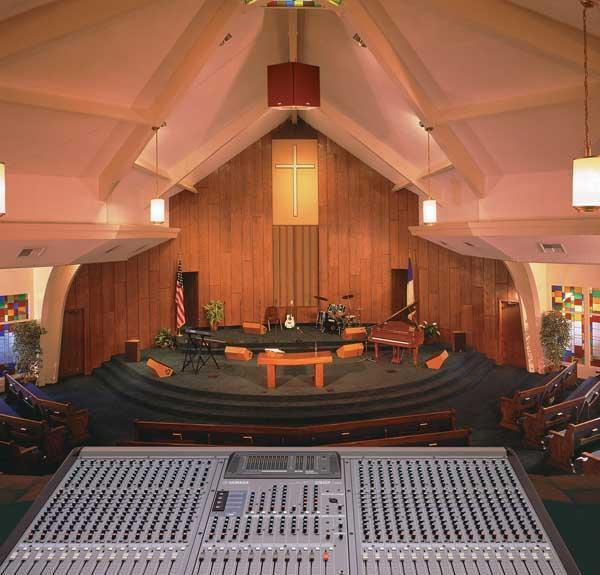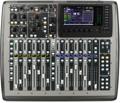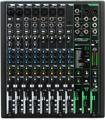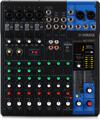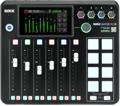How to Choose a Mixer
The mixer forms the heart of your PA system or recording studio, providing audio inputs and outputs, routing capabilities and more. This Sweetwater Buying Guide includes information that can help you choose the right mixer for your needs. Since there’s so much to consider when purchasing a mixer, don’t hesitate to call us at (800) 222-4700 for more information.
Live and Studio Mixers
Key Mixer Terms
Analog and Digital Mixers
What to Look For…
Live and Studio Mixers
 Studio and live sound mixers alike are systems for combining signals and routing audio where it needs to go. The application you want to use it for will dictate the type and quantity of I/O you need. For example, a live sound mixer generally needs to feed a set of main speakers and also provide a few monitor mixes, whereas a traditional studio mixer might also require direct outputs from every channel for multitrack recording. The line between “studio” and “live sound” mixers is pretty blurry these days, so the best place to start is with the various parts that make up a mixer.
Studio and live sound mixers alike are systems for combining signals and routing audio where it needs to go. The application you want to use it for will dictate the type and quantity of I/O you need. For example, a live sound mixer generally needs to feed a set of main speakers and also provide a few monitor mixes, whereas a traditional studio mixer might also require direct outputs from every channel for multitrack recording. The line between “studio” and “live sound” mixers is pretty blurry these days, so the best place to start is with the various parts that make up a mixer.
Key Mixer Terms
Channels
Simply put, the more channels a mixer has, the more stuff you can hook up to it. Channels (like most mixer technology) come in multiple flavors and can be either mono or stereo. They accept mic and/or line level signals and normally have a preamp to get the input up to an appropriate level, plus a fader for controlling the channel’s output. Usually, each channel will have an equalizer, auxiliary sends, and pan control, but some mixers can be as simple as a handful of extremely rudimentary channels and a master output.
Buses
The purpose of each channel in a mixer is to pass signal along to one or more buses. The main output of the mixer is connected to the master mix bus, which is fed by the channel faders. Similarly, each auxiliary bus (aux send) is fed by a separate volume control on the channel and exits the mixer via its own output jack. Aux buses can either act independently of the channel’s volume (pre-fader) or be affected by the output fader (post-fader). These special outputs are extremely useful for monitor mixes, headphone mixes, recording mixes, and as effects sends. Some mixing consoles even have a special aux bus just for effects, which may include an onboard effects processor or dedicated return channel.
Groups
Some large-format mixers feature channel grouping (sometimes still referred to as VCA groups), which is a useful way to manage large numbers of channels. Essentially, each group matrix is like its own mixer that sits between your channels and the main bus. The way groups work is pretty simple. You assign the output of each channel you’d like to control to a bus that feeds a group fader. For example, you might send all of your drums to Group 1 and all of your vocals to Group 2. Each group has its own output fader, which then feeds into the master bus. This lets you control entire sections of your mix with just a few faders, without affecting the relative mix of the channels in each group.
Mute Groups and Scenes
In addition to mix groups, some mixers also have mute groups. These let you assign individual channels a single control that you can use to quickly mute or unmute multiple channels at once. That’s handy if part of the band only plays for a few songs or you want to mute the whole band while a presenter is speaking. More advanced mixing consoles will let you store multiple mute scenes, which allow you to store several configurations of muted and unmuted channels for quick recall, which is great for theater and worship sound.
Inserts and Direct Outputs
Whereas aux sends are useful for effects you want to apply to multiple channels (e.g., reverb or delay), channel inserts are ideal for adding outboard processors such as compressors and equalizers to individual channels. A channel’s insert point is typically right after its preamp in the signal flow and either uses individual send and return jacks or a single 1/4″ insert jack, which requires a special insert cable to use. By contrast, direct outputs simply send a copy of the preamplifier signal out of the board, which makes them useful for sending individual feeds to an external recorder or audio interface.
Analog and Digital Mixers
Analog Mixers
 In an analog mixer, every channel, bus, preamp, EQ, and other component is comprised of physical circuitry (e.g., wires, resistors, potentiometers, and switches). Essentially, analog mixers are extremely simple, with individual hands-on controls for every function and routing option. Once you know your way around an analog board, you can quickly figure out what’s going on with a quick glance across the surface and when you need to tweak a setting, you can just reach out and grab it.
In an analog mixer, every channel, bus, preamp, EQ, and other component is comprised of physical circuitry (e.g., wires, resistors, potentiometers, and switches). Essentially, analog mixers are extremely simple, with individual hands-on controls for every function and routing option. Once you know your way around an analog board, you can quickly figure out what’s going on with a quick glance across the surface and when you need to tweak a setting, you can just reach out and grab it.
Shop for Analog Mixers
Digital Mixers
 Shortly after entering the board (usually right after the preamp stage) the analog signal in a digital mixer is converted into digital data for processing and routing. Essentially, a digital mixer is a sophisticated computer with a bunch of AD/DA converters and a specialized control surface attached. Digital mixers offer a number of conveniences analog boards don’t. For instance, DSP chips are much smaller and far less expensive than their analog counterparts, so you’ll find digital boards loaded with advanced EQs, dynamics processing, and effects, which can seriously cut down on outboard gear. The ability to store and instantly recall entire setups is also a major advantage.
Shortly after entering the board (usually right after the preamp stage) the analog signal in a digital mixer is converted into digital data for processing and routing. Essentially, a digital mixer is a sophisticated computer with a bunch of AD/DA converters and a specialized control surface attached. Digital mixers offer a number of conveniences analog boards don’t. For instance, DSP chips are much smaller and far less expensive than their analog counterparts, so you’ll find digital boards loaded with advanced EQs, dynamics processing, and effects, which can seriously cut down on outboard gear. The ability to store and instantly recall entire setups is also a major advantage.
Digital mixers do tend to come with a higher learning curve, and they often have just a single master control section for configuring all of your channels. However, large screens and intuitive layouts often make up for this limitation. What’s more, advanced features such as Ethernet audio integration (e.g., Dante), Wi-Fi networking, and tablet PC control all provide some level of access unavailable to analog boards. And when you take into account the generally higher sound quality they offer, it’s little wonder that digital mixers have become standard live sound gear.
Shop for Digital Mixers
Line Mixers
![]() Line mixers are nearly always analog mixers that deal exclusively with line-level signal. They are extremely simple, often with only a single volume control per channel. Live, line mixers let you combine multiple sources such as in-the-booth playback devices into a single output, freeing up channels (and preamps) on you main board. In the studio, many engineers use high-end line mixers called summing mixers to consolidate their final mixes.
Line mixers are nearly always analog mixers that deal exclusively with line-level signal. They are extremely simple, often with only a single volume control per channel. Live, line mixers let you combine multiple sources such as in-the-booth playback devices into a single output, freeing up channels (and preamps) on you main board. In the studio, many engineers use high-end line mixers called summing mixers to consolidate their final mixes.
Shop for Line Mixers
Shop for Summing Mixers
Powered Mixers
 Powered mixers combine a mixer and a power amplifier into a single unit. These are ideal for portable PA systems. In fact, sometimes powered mixers are integrated with matched loudspeakers as well to create extremely handy all-in-one small-format PA systems.
Powered mixers combine a mixer and a power amplifier into a single unit. These are ideal for portable PA systems. In fact, sometimes powered mixers are integrated with matched loudspeakers as well to create extremely handy all-in-one small-format PA systems.
Shop for Powered Mixers
Shop for All-in-one PA Systems
What to Look For In a Mixer
So, how do you narrow down the wide selection of mixers on the market to find the one that’s best for you? Begin by creating a checklist of your own parameters:
Channels and Inputs
How many do you need? How many microphones do you need to connect? Don’t forget to include stereo inputs for keyboards or direct inputs for bass and guitar. Also, you’ll want to keep future expansion in mind.
EQs
Some mixers offer basic low/high frequency adjustments, whereas others provide multi-band parametric EQ on each channel with high and low shelving. How much sound-shaping capability do you expect from your mixer?
Directs Outs/Inserts
Do you need input channels to be routed to external processing gear or recording systems, or will you only be mixing input channels to the main mixer outputs?
Onboard Processors and Effects
One appeal of onboard processing is that you won’t need to worry about adding (or transporting) outboard gear. However, if you’re putting a new mixer into a rig that already has outboard processing gear, then onboard processing might not be a priority.
Buses and Routing
This depends on your signal routing needs. If you’re sending out monitor mixes, recording feeds, and external effects mixes, then you’ll need enough aux sends to handle the demand.


